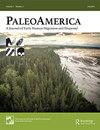Reconstructing Terminal Pleistocene-Early Holocene Environmental Change at Page-Ladson, Florida Using Diatom Evidence
IF 1.7
Q1 ANTHROPOLOGY
引用次数: 6
Abstract
ABSTRACT The Page-Ladson site, currently buried and submerged in a sinkhole in northwestern Florida, demonstrates evidence of human occupation in North America by 14,550 calendar years ago (cal yr BP). This paper combines new diatom evidence with existing palynological data to strengthen paleoenvironmental interpretations at the site. The Page-Ladson sinkhole was not entirely submerged between ∼15,100 and 14,400 cal yr BP. Conditions at the site became warmer and wetter, and the sinkhole became a turbid pond from ∼14,400 to 12,900 cal yr BP. From ∼12,900 cal yr BP until ∼11,000 cal yr BP, a disappearance of diatoms in the coring location suggests the sinkhole margin was dry. Water levels rose between 11,000 and 9000 cal yr BP, submerging the coring location on the pond margin. These environmental data help contextualize the archaeological data in the region.利用硅藻证据重建佛罗里达州Page-Ladson地区更新世-全新世早期环境变化
Page-Ladson遗址目前被埋在佛罗里达州西北部的一个天坑中,它展示了14550日历年前人类在北美居住的证据。本文将新的硅藻证据与现有孢粉资料相结合,以加强该遗址的古环境解释。Page-Ladson天坑在~ 15,100和14,400 calyr BP之间没有完全被淹没。在约14400至12900 calyr BP期间,该地点的条件变得更加温暖和潮湿,并且天坑变成了一个浑浊的池塘。从~ 12,900 calyr BP到~ 11,000 calyr BP,在取心位置硅藻的消失表明天坑边缘是干燥的。水位在11000 - 9000 calyr BP之间上升,淹没了池塘边缘的取心位置。这些环境数据有助于对该地区的考古数据进行背景分析。
本文章由计算机程序翻译,如有差异,请以英文原文为准。
求助全文
约1分钟内获得全文
求助全文
来源期刊

PaleoAmerica
Earth and Planetary Sciences-Paleontology
CiteScore
3.70
自引率
0.00%
发文量
15
期刊介绍:
PaleoAmerica disseminates new research results and ideas about early human dispersal and migrations, with a particular focus on the Americas. It fosters an interdisciplinary dialog between archaeologists, geneticists and other scientists investigating the dispersal of modern humans during the late Pleistocene. The journal has three goals: First and foremost, the journal is a vehicle for the presentation of new research results. Second, it includes editorials on special topics written by leaders in the field. Third, the journal solicits essays covering current debates in the field, the state of research in relevant disciplines, and summaries of new research findings in a particular region, for example Beringia, the Eastern Seaboard or the Southern Cone of South America. Although the journal’s focus is the peopling of the Americas, editorials and research essays also highlight the investigation of early human colonization of empty lands in other areas of the world. As techniques are developing so rapidly, work in other regions can be very relevant to the Americas, so the journal will publish research relating to other regions which has relevance to research on the Americas.
 求助内容:
求助内容: 应助结果提醒方式:
应助结果提醒方式:


